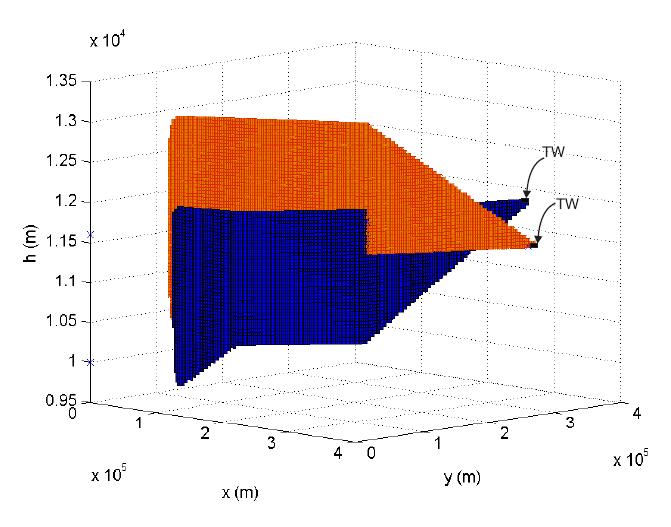Air traffic control
This research project is not currently active and this page is not regularly updated. It is provided here for archival purposes.
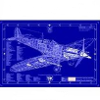
The primary concern of Air Traffic Control (ATC) is to maintain safe separation between the aircraft in the airspace. ATC is currently very much a human-in-the-loop process, with air traffic controllers ultimately responsible for safety. The aim of our research in this area is to facilitate the work of human controllers by introducing automation and decision support tools, based on modeling, estimation, distributed control, and optimization methods.
Despite technological advances, the Air Traffic Management system is still, to a large extent, built around a rigidly structured airspace and a centralized, mostly human-operated system architecture. Even though this system has operated reliably for a many years, the increasing demand for air travel is beginning to stress it to its limits. Air-Traffic in Europe is projected to double every 10 to 14 years; even higer rates of growth are expected in the U.S., Asia and for trans-oceanic flights. This increase is likely to cause both safety and performance degradation in the near future, and place an additional burden on the already overloaded human operators. Increase workload is believed, for example, to be one of the major causes that contributed to a 33% increase in controller errors in the U.S. over the period 1996-2000.
In the current organization of the Air Traffic Management (ATM) system the centralized Air Traffic Control (ATC) is in complete control of air traffic and ultimately responsible for safety. Before take off, aircraft file flight plans which cover the entire flight. During the flight, ATC sends additional instructions to them, depending on the actual traffic, to improve traffic flow and avoid dangerous encounters. The primary concern of ATC is to maintain safe separation between the aircraft.
Research
The main aim of our research is to facilitate the work of ATC by automation. Towards this direction, our research can be divided in the following areas:
Modeling of aircraft, Flight Management System and Weather
In this area, our goal is to produce an accurate model (from the point of view of the air traffic controller) to simulate aircraft flights.
A complete model and a fast-time simulator for the validation of trajectory prediction, conflict detection and conflict resolution algorithms has been developed. Our model allows simulation of multiple flights taking place at the same time. The model we use is stochastic and hybrid. In particular, the model comprises:
- Continuous dynamics, arising from the physical motion of the aircraft.
- Discrete dynamics, arising from the flight plan and the logic variables embedded in the Flight Management System.
- Stochastic dynamics, arising from the weather and the sensor noises.
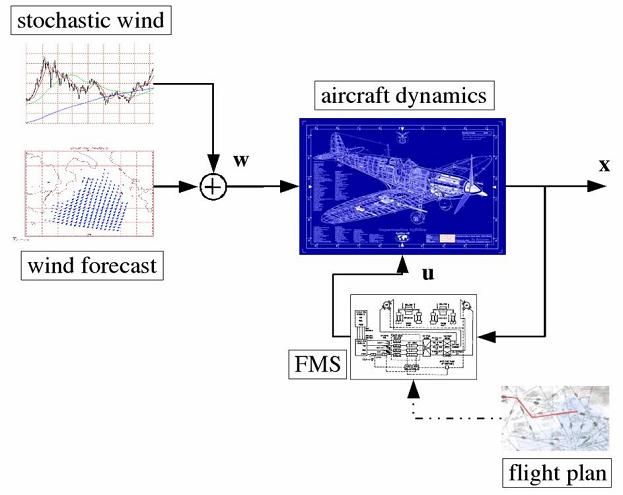
The weather enters in the model through the wind speed, which is modeled as a sum of two components: the nominal, which represents the weather forecasts and the stochastic, representing deviations from the forecasts. The stochastic component is assumed to be zero mean and correlated in space and time.
Adaptive Trajectory Prediction Techniques
In this area, methods for predicting accurately the future position of aircraft are developed.
The characteristics of a trajectory will change with time and circumstances. An adaptive technique can update and refine the current trajectory prediction every time new measurements become available by incorporating them in the current result. It constitutes a probabilistic approach in the problem of prediction, in the sense that it assigns certain plausibility for each possible outcome given all the available information. Moreover, it is not a final prediction, but can always be improved in the presence of new data.
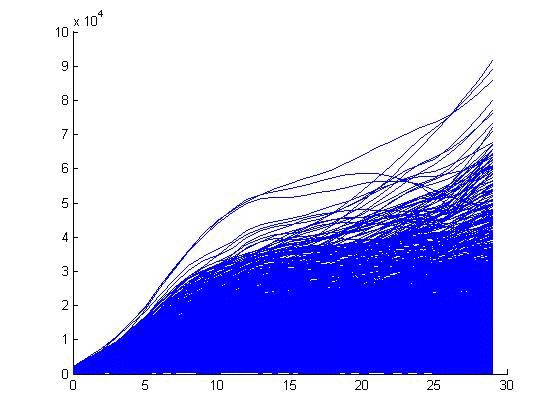
Subliminal Control
This refers to control imperceptible from the Air Traffic Controller (ATCo), mainly focused to reduce ATCo's workload.
Subliminal control is a novel concept for computer-aided air traffic management. The premise is that a large part of an air traffic controller workload is devoted to monitoring situations which may become unsafe. The aim of the automated subliminal control system is to carry out small adjustments in the speeds of aircraft early enough to prevent the perception of a risk of conflict by the air traffic controller. These actions have to be small so as to be imperceptible by the air traffic controller, who is then delivered a "lucky traffic" and can handle more aircraft.
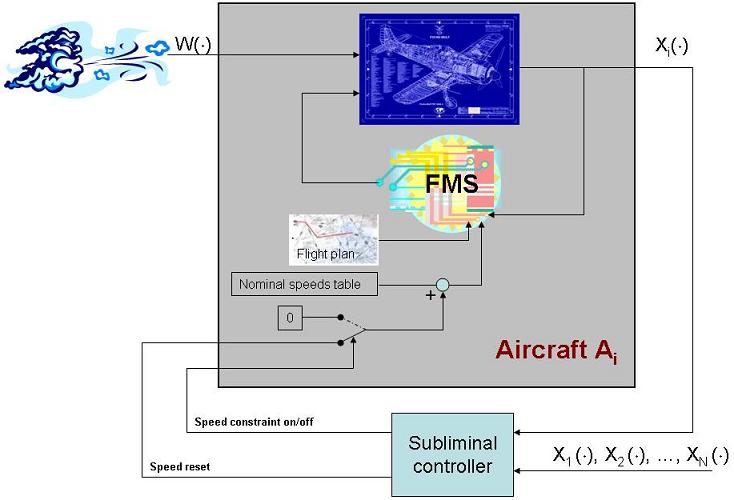
We have developed a mathematical framework for subliminal control using hybrid system formulation. Our contribution is twofold:
- Perceived risk/complexity estimation: We use a hybrid uncertain system model to compute a function which associates a risk/complexity level with a traffic situation to the value function of an appropriate optimal control problem.
- Subliminal control computation: We formulate the subliminal control problem as a robust optimization problem in which the cost is the risk/complexity perceived by the air traffic controller.
Conflict Resolution
In this area, automated methods for resolving conflicts in ATC are developed.
During flight, the aircraft have to maintain safety. In terms of air traffic control, this means that aircraft have to maintain a minimum separation between each other during all the flight. Any violation of this minimum separation is defined as a conflict.
The object of conflict resolution is to detect impending conflicts and resolve them by changing the flight plans, subject to some constraints and priorities.
Today conflict resolution is mainly human-based, operated by the air traffic controllers. Our object is to produce an efficient automated conflict resolution algorithm, using different cost criteria, depending on whether we want our control to be subliminal or not.
During the past years, research has determined several ways to deal with this problem. Efforts done in this field can be divided in two sectors:
Centralized solutions:
In this approach, the Conflict Detection and Resolution (CDR) algorithm has to detect and resolve all impending conflicts in a specific airspace sector of interest in a centralized manner (i.e. on the ground).
Decentralized solutions:
This approach, often referenced as Free Flight or Self Separation, introduces a different concept, where aircraft are allowed to fly in the airspace without the intervention of a central Air Traffic Control system. In this case, the aircraft are responsible for maintaining the separation between them, detecting and resolving all impending conflicts in the airspace. This approach, although more complicated, is envisioned to capture the need for increased air transportation in the future, taking advantage of the more accurate information that aircraft have onboard.
One powerful technique, widely used in robotics, that can guarantee collision avoidance between the moving robots is the Navigation Functions (NF) technique. This method has been used with great success in several robotics applications. Trying to use it in the air traffic control framework, though, is much more complicated, as aircraft have additional dynamic constraints, such as speed constraints. Applying directly the NF method for CDR produces conflict-free trajectories, but unfortunately aircraft do not respect any of the operational constraints. To surpass this disadvantage, we have employed the use of Model Predictive Control, a technique designed to deal with system constraints. A major difficulty in this formulation, though, is the intractability of the control scheme, as the resulting optimization problem is non-convex. To overcome this problem, we employ the use of randomized optimization techniques, which can deal with complex systems, while under some assumptions can provide some probabilistic guarantees on the convergence to the optimal value of the problem under consideration. The methods we have used so far are based on a variation of Simulated Annealing, using Markov Chain Monte Carlo.
Air Traffic Management with Target Windows
In this area methods for tracking '4D' constraints and conflict resolution algorithms that respect these constraints will be developed.
A major difficulty with accommodating the expected increase in air traffic is uncertainty about the future evolution of flights. Target Windows (TW), proposed by the CATS project, are spatial and temporal constraints placed between sectors at different parts of the flight plan of each aircraft (Fig. 1), whose position and interval size reflects constraints imposed by downstream components such as punctuality at denstination, conjested en-route areas, or safety requirements. They represent the commitment of each actor (air traffic controllers, airports, airlines, air navigation service providers) to deliver a particular aircraft within a specific constraint set.
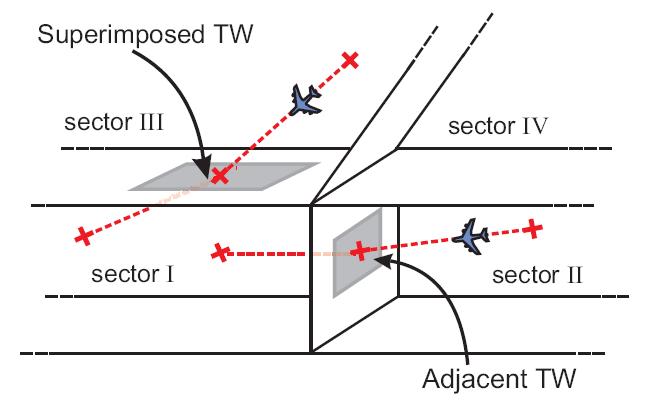
Our goal is to quantify the maneuverability freedom of each aircraft afforded by a specific TW, and provide a centralized solution for conflict resolution in a multi-agent setting. Considering a two-aircraft collision avoidance scenario, our objective is to determine the set of initial states that an aircraft can start and despite the wind can reach its TW while avoiding conflict with other aircraft. This is a reach-avoid problem, and since disturbance, in that case the wind is present, it could be treated as a pursuit-evasion differential game and be coded as a backward reachability computation.
This reach-avoid sets could be characterized through the level set of the value function of an appropriate optimal control problem. Since state constraints (the avoid set) are also present, the value function can be shown to be the unique continuous viscosity solution to a quasi-variational inequality. Computational tools based on external page Level Set Methods can be then used so as to solve the problem numerically.
Under the reasonable assumption that aircraft can track laterally very well, our current objectives are:
a) Determine the backward reachable tube of each TW that illustrates the maneuverability freedom that the corresponding aircraft has. (Fig. 2).
b) Perform conflict detection, i.e. determine the area where a conflict might occur (Fig. 2).
c) Apply our reach-avoid approach so as to construct conflict free tubes (Fig. 3).
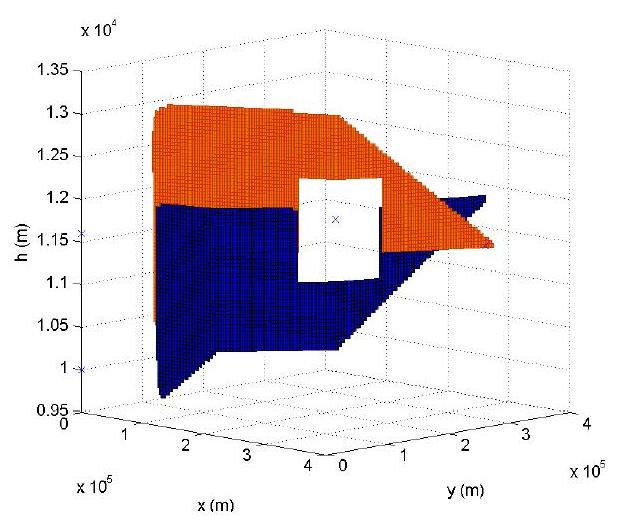
All points in the tubes represent states that an aircraft could start at some time and reach the TW. Next step would be to use the bounds obtained from the reach-avoid computation in order to perform conflict resolution by optimizing some cost criterion, and validate our approach with fast time simulation studies using realistic aircraft, flight plans, flight management systems and wind uncertainty.
